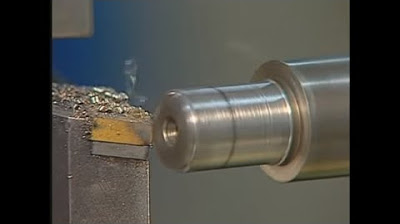What is Bearing? Types of Bearings and How they Work?
Summary
TLDRThis script delves into the world of bearings, essential components in various machinery from small trolleys to massive power plants. It explains their purpose to reduce friction and wear by preventing metal-to-metal contact, while enhancing speed and efficiency. The video covers a range of bearing types, including ball, roller, plane, fluid, magnetic, jewel, and flexure bearings, each serving specific functions and applications. It highlights the importance of bearings in modern industry, from reducing energy consumption to supporting high loads and ensuring precision in movement.
Takeaways
- 🔧 Bearings are essential components in a wide range of applications, from small supermarket trolleys to large power plants, facilitating movement and reducing friction.
- 🛠️ The primary purpose of bearings is to prevent direct metal-to-metal contact, thereby reducing friction, heat generation, wear and tear, and energy consumption.
- 🏗️ Bearings support the load of rotating elements and can handle radial, axial, or a combination of both types of loads.
- 🔄 Rolling element bearings, such as ball and roller bearings, use rolling friction instead of sliding friction to facilitate the free movement of parts in rotational motion.
- 🏓 Ball bearings consist of balls trapped between two races and are common for their low friction and ability to support axial loads in two directions.
- 🔄 Different types of ball bearings, like deep groove, angular contact, self-aligning, and thrust bearings, are designed for specific applications and load capacities.
- 🛠️ Roller bearings, with cylindrical rolling elements, maintain accurate alignment and can carry heavy loads, making them suitable for machinery with frequent starts and stops.
- 📐 Plane bearings are the simplest type, often consisting of just a bearing surface, and are used for various types of motion in industries like agriculture and construction.
- 💧 Fluid bearings use pressurized gas or liquid to eliminate friction and are ideal for high-speed and high-load applications.
- 🧲 Magnetic bearings leverage magnetic levitation to support shafts with no physical contact, offering zero wear and the ability to handle high relative speeds.
- 💎 Jewel bearings, typically used in precision instruments and mechanical watches, offer low friction, long life, and dimensional accuracy.
- 🔗 Flexure bearings are part of compliant mechanisms, providing angular compliance without the need for lubrication and exhibiting very low friction.
Q & A
What is the primary function of bearings in various machinery?
-The primary function of bearings is to prevent direct metal-to-metal contact between two elements in relative motion, thereby reducing friction, heat generation, wear and tear, and energy consumption.
How do bearings enhance the speed and efficiency of an object?
-Bearings enhance speed and efficiency by reducing friction through the use of rolling elements, which allows for smoother movement compared to sliding motion.
What are the different types of bearings mentioned in the script?
-The script mentions rolling element bearings, plane bearings, fluid bearings, magnetic bearings, jewel bearings, and flexure bearings.
What is the basic principle behind rolling element bearings?
-Rolling element bearings operate on the principle that it is easier to roll an object, like a wheel, than to slide it, due to the lower magnitude of rolling friction compared to sliding friction.
What are the two major types of rolling element bearings and how do they differ?
-The two major types are ball bearings and roller bearings. Ball bearings use balls as rolling elements and have low friction but limited load capacity. Roller bearings use cylindrical elements and can carry heavier loads and maintain accurate alignment.
What is unique about self-aligning ball bearings compared to other types of ball bearings?
-Self-aligning ball bearings have an outer ring with a concave shape, allowing the inner ring to self-align, which is useful for applications where the load may not be perfectly aligned.
How do tapered roller bearings differ from other roller bearings in terms of load handling?
-Tapered roller bearings are designed to handle higher axial loads in addition to radial loads, due to their conical shape which allows the rollers to fit between races that are also conical sections.
What is the advantage of fluid bearings in high-speed machinery?
-Fluid bearings rely on pressurized gas or liquid to carry the load and eliminate friction, making them suitable for high-speed machinery where metallic bearings would have a short life and generate high noise and vibration.
How do magnetic bearings achieve zero wear and tear?
-Magnetic bearings use the concept of magnetic levitation to hold the shaft in mid-air without physical contact, thus eliminating wear and tear.
What are the characteristics of jewel bearings that make them suitable for precision instruments?
-Jewel bearings offer low friction, long life, and dimensional accuracy, making them ideal for precision instruments such as mechanical watches.
What is the main advantage of flexure bearings in terms of maintenance?
-Flexure bearings require no lubrication and exhibit very low friction, making them simple, inexpensive, and easier to repair without specialized equipment.
Outlines

This section is available to paid users only. Please upgrade to access this part.
Upgrade NowMindmap

This section is available to paid users only. Please upgrade to access this part.
Upgrade NowKeywords

This section is available to paid users only. Please upgrade to access this part.
Upgrade NowHighlights

This section is available to paid users only. Please upgrade to access this part.
Upgrade NowTranscripts

This section is available to paid users only. Please upgrade to access this part.
Upgrade NowBrowse More Related Video

Gear Forces and Power Transmission of SPUR GEARS in Just Over 12 Minutes!

Hydraulics - Basic Principles of Hydromechanics - Airframes & Aircraft Systems #4

How do resistors work? (Animated) | Basic Electronics

Bearing Problems & Navigation

LUBRICATION SYSTEM | IT'S EFFECTS | SPLASH & FORCE FEED LUBRICATION SYSTEM | FARM POWER & MACHINERY

Telecurso 2000 Manutenção 17 Recuperação de elementos mecânicos
5.0 / 5 (0 votes)